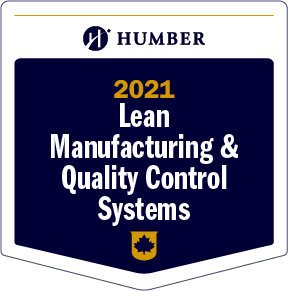
Lean Manufacturing & Quality Control Systems
Alignments
eCampusOntario Micro-certification Principles and Framework
This framework was developed by a community working group of employers, colleges, universities and other public agencies dedicated to building a harmonized micro-certification ecosystem in Ontario.
Humber Learning Outcomes Framework
The disrupted nature of work is putting increased pressure on the knowledge and skillsets needed for success in the workplace.
Humber is addressing these challenges by reimagining our future. Supported by an ambitious learning outcomes framework that highlights key mindsets and skills, the Humber experience deeply engages students in their learning and empowers them to think critically, make bold choices and become career-ready citizens.
Criteria
In addition, Quality Control concepts based on statistical models and process simulations which are an integral part of advanced manufacturing have been discussed.
Learning Time: 42 hours
The earner can:
- Explain the elements of automated manufacturing systems and Robotic role in industrial automation including Safety and general specifications which are commonly used in robotic industry.
- Differentiate Industrial robotic arms and their classifications based on robotic joints, degrees of freedom, and redundancy.
- Program the multiple industrial robots for simple and intermediate level of production tasks in the advanced manufacturing environment, including: Power up, Initialize, Manually Operate, and Shut down the Robot systems.
- Describe the most common configurations of the robotic control system; identify each element of a robotic control system with their specifications.
- Describe the Work Cell Interface subsystem, including types of sensors, vision system components, safety features, and using robot I/O to interface robots and other devices in the Work Cell.
- Demonstrate the basic type of robotic sensors and their integration with robotic arm and as well as the cell environment; identify advantages and disadvantages of each type of sensors.
- Classify different types of robotic actuators and their specifications to control the speed and direction of robotic arm; identify advantages and disadvantages of each type of actuators.
- Describe most common configurations of the end-of-arm tooling subsystem; identify advantages and disadvantages of each configuration.
- Describe the collaborative Robots and the basic features of collaborative robots including safety features and vision system.
- Demonstrate the integration of robotic arms in advanced manufacturing; including robotic accuracy, resolution and repeatability
The assessment of learning includes both the earner’s skills and knowledge - before, during and after training. Assessment during micro-learning is through informative and summative assessments such as short-answer questions, hands-on activities and troubleshooting. Learners are assessed upon completion of related micro-learning. If unsuccessful on first attempt, a learner may repeat the assessment at a later date.
Assessments are conducted by Humber faculty.
Lean Manufacturing & Quality Control Systems is one of the series in the RapidSkills, Advanced Manufacturing Micro-credentials program supported by the Government of Ontario.